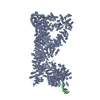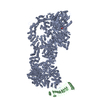+ データを開く
データを開く
- 基本情報
基本情報
| 登録情報 |  | |||||||||
|---|---|---|---|---|---|---|---|---|---|---|
| タイトル | Local refinement of the RNF213 C-terminal and hinge domains in the structure of human RNF213 bound to the secreted effector IpaH1.4 from Shigella flexneri | |||||||||
 マップデータ マップデータ | Focused refinement of the RNF213 C-terminal and hinge domains in the RNF213-IpaH1.4 complex (post-processed, auto-sharpened map) | |||||||||
 試料 試料 |
| |||||||||
 キーワード キーワード | RNF213 / IpaH1.4 / IpaH / E3 ligase / RING / LRR / NEL / secreted effector / Shigella / inhibitor / complex / AAA / ATPase / ANTIMICROBIAL PROTEIN | |||||||||
| 生物種 |  Homo (哺乳類) Homo (哺乳類) | |||||||||
| 手法 | 単粒子再構成法 / クライオ電子顕微鏡法 / 解像度: 3.1 Å | |||||||||
 データ登録者 データ登録者 | Naydenova K / Randow F | |||||||||
| 資金援助 |  英国, 2件 英国, 2件
| |||||||||
 引用 引用 |  ジャーナル: Nat Struct Mol Biol / 年: 2025 ジャーナル: Nat Struct Mol Biol / 年: 2025タイトル: Shigella flexneri evades LPS ubiquitylation through IpaH1.4-mediated degradation of RNF213. 著者: Katerina Naydenova / Keith B Boyle / Claudio Pathe / Prathyush Pothukuchi / Ana Crespillo-Casado / Felix Scharte / Pierre-Mehdi Hammoudi / Elsje G Otten / Neal M Alto / Felix Randow /    要旨: Pathogens have evolved diverse strategies to counteract host immunity. Ubiquitylation of lipopolysaccharide (LPS) on cytosol-invading bacteria by the E3 ligase RNF213 creates 'eat me' signals for ...Pathogens have evolved diverse strategies to counteract host immunity. Ubiquitylation of lipopolysaccharide (LPS) on cytosol-invading bacteria by the E3 ligase RNF213 creates 'eat me' signals for antibacterial autophagy, but whether and how cytosol-adapted bacteria avoid LPS ubiquitylation remains poorly understood. Here, we show that the enterobacterium Shigella flexneri actively antagonizes LPS ubiquitylation through IpaH1.4, a secreted effector protein with ubiquitin E3 ligase activity. IpaH1.4 binds to RNF213, ubiquitylates it and targets it for proteasomal degradation, thus counteracting host-protective LPS ubiquitylation. To understand how IpaH1.4 recognizes RNF213, we determined the cryogenic electron microscopy structure of the IpaH1.4-RNF213 complex. The specificity of the interaction is achieved through the leucine-rich repeat of IpaH1.4, which binds the RING domain of RNF213 by hijacking the conserved RING interface required for binding to ubiquitin-charged E2 enzymes. IpaH1.4 also targets other E3 ligases involved in inflammation and immunity through binding to the E2-interacting face of their RING domains, including the E3 ligase LUBAC that is required for the synthesis of M1-linked ubiquitin chains on cytosol-invading bacteria downstream of RNF213. We conclude that IpaH1.4 has evolved to antagonize multiple antibacterial and proinflammatory host E3 ligases. | |||||||||
| 履歴 |
|
- 構造の表示
構造の表示
| 添付画像 |
|---|
- ダウンロードとリンク
ダウンロードとリンク
-EMDBアーカイブ
| マップデータ |  emd_50919.map.gz emd_50919.map.gz | 12.6 MB |  EMDBマップデータ形式 EMDBマップデータ形式 | |
|---|---|---|---|---|
| ヘッダ (付随情報) |  emd-50919-v30.xml emd-50919-v30.xml emd-50919.xml emd-50919.xml | 18.1 KB 18.1 KB | 表示 表示 |  EMDBヘッダ EMDBヘッダ |
| FSC (解像度算出) |  emd_50919_fsc.xml emd_50919_fsc.xml | 13.5 KB | 表示 |  FSCデータファイル FSCデータファイル |
| 画像 |  emd_50919.png emd_50919.png | 135.5 KB | ||
| マスクデータ |  emd_50919_msk_1.map emd_50919_msk_1.map | 216 MB |  マスクマップ マスクマップ | |
| Filedesc metadata |  emd-50919.cif.gz emd-50919.cif.gz | 4.6 KB | ||
| その他 |  emd_50919_additional_1.map.gz emd_50919_additional_1.map.gz emd_50919_half_map_1.map.gz emd_50919_half_map_1.map.gz emd_50919_half_map_2.map.gz emd_50919_half_map_2.map.gz | 171.4 MB 171.2 MB 171.5 MB | ||
| アーカイブディレクトリ |  http://ftp.pdbj.org/pub/emdb/structures/EMD-50919 http://ftp.pdbj.org/pub/emdb/structures/EMD-50919 ftp://ftp.pdbj.org/pub/emdb/structures/EMD-50919 ftp://ftp.pdbj.org/pub/emdb/structures/EMD-50919 | HTTPS FTP |
-検証レポート
| 文書・要旨 |  emd_50919_validation.pdf.gz emd_50919_validation.pdf.gz | 617 KB | 表示 |  EMDB検証レポート EMDB検証レポート |
|---|---|---|---|---|
| 文書・詳細版 |  emd_50919_full_validation.pdf.gz emd_50919_full_validation.pdf.gz | 616.5 KB | 表示 | |
| XML形式データ |  emd_50919_validation.xml.gz emd_50919_validation.xml.gz | 21 KB | 表示 | |
| CIF形式データ |  emd_50919_validation.cif.gz emd_50919_validation.cif.gz | 28 KB | 表示 | |
| アーカイブディレクトリ |  https://ftp.pdbj.org/pub/emdb/validation_reports/EMD-50919 https://ftp.pdbj.org/pub/emdb/validation_reports/EMD-50919 ftp://ftp.pdbj.org/pub/emdb/validation_reports/EMD-50919 ftp://ftp.pdbj.org/pub/emdb/validation_reports/EMD-50919 | HTTPS FTP |
-関連構造データ
- リンク
リンク
| EMDBのページ |  EMDB (EBI/PDBe) / EMDB (EBI/PDBe) /  EMDataResource EMDataResource |
|---|
- マップ
マップ
| ファイル |  ダウンロード / ファイル: emd_50919.map.gz / 形式: CCP4 / 大きさ: 216 MB / タイプ: IMAGE STORED AS FLOATING POINT NUMBER (4 BYTES) ダウンロード / ファイル: emd_50919.map.gz / 形式: CCP4 / 大きさ: 216 MB / タイプ: IMAGE STORED AS FLOATING POINT NUMBER (4 BYTES) | ||||||||||||||||||||||||||||||||||||
|---|---|---|---|---|---|---|---|---|---|---|---|---|---|---|---|---|---|---|---|---|---|---|---|---|---|---|---|---|---|---|---|---|---|---|---|---|---|
| 注釈 | Focused refinement of the RNF213 C-terminal and hinge domains in the RNF213-IpaH1.4 complex (post-processed, auto-sharpened map) | ||||||||||||||||||||||||||||||||||||
| 投影像・断面図 | 画像のコントロール
画像は Spider により作成 | ||||||||||||||||||||||||||||||||||||
| ボクセルのサイズ | X=Y=Z: 1.228 Å | ||||||||||||||||||||||||||||||||||||
| 密度 |
| ||||||||||||||||||||||||||||||||||||
| 対称性 | 空間群: 1 | ||||||||||||||||||||||||||||||||||||
| 詳細 | EMDB XML:
|
-添付データ
-マスク #1
| ファイル |  emd_50919_msk_1.map emd_50919_msk_1.map | ||||||||||||
|---|---|---|---|---|---|---|---|---|---|---|---|---|---|
| 投影像・断面図 |
| ||||||||||||
| 密度ヒストグラム |
-追加マップ: Focused refinement of the RNF213 C-terminal and hinge...
| ファイル | emd_50919_additional_1.map | ||||||||||||
|---|---|---|---|---|---|---|---|---|---|---|---|---|---|
| 注釈 | Focused refinement of the RNF213 C-terminal and hinge domains in the RNF213-IpaH1.4 complex (non-filtered, non-sharpened map) | ||||||||||||
| 投影像・断面図 |
| ||||||||||||
| 密度ヒストグラム |
-ハーフマップ: Focused refinement of the RNF213 C-terminal and hinge...
| ファイル | emd_50919_half_map_1.map | ||||||||||||
|---|---|---|---|---|---|---|---|---|---|---|---|---|---|
| 注釈 | Focused refinement of the RNF213 C-terminal and hinge domains in the RNF213-IpaH1.4 complex (half map 1) | ||||||||||||
| 投影像・断面図 |
| ||||||||||||
| 密度ヒストグラム |
-ハーフマップ: Focused refinement of the RNF213 C-terminal and hinge...
| ファイル | emd_50919_half_map_2.map | ||||||||||||
|---|---|---|---|---|---|---|---|---|---|---|---|---|---|
| 注釈 | Focused refinement of the RNF213 C-terminal and hinge domains in the RNF213-IpaH1.4 complex (half map 2) | ||||||||||||
| 投影像・断面図 |
| ||||||||||||
| 密度ヒストグラム |
- 試料の構成要素
試料の構成要素
-全体 : E3 ligase RNF213, bound to the secreted effector IpaH1.4 from Shi...
| 全体 | 名称: E3 ligase RNF213, bound to the secreted effector IpaH1.4 from Shigella flexneri |
|---|---|
| 要素 |
|
-超分子 #1: E3 ligase RNF213, bound to the secreted effector IpaH1.4 from Shi...
| 超分子 | 名称: E3 ligase RNF213, bound to the secreted effector IpaH1.4 from Shigella flexneri タイプ: complex / ID: 1 / 親要素: 0 / 含まれる分子: #1-#2 |
|---|---|
| 由来(天然) | 生物種:  Homo (哺乳類) Homo (哺乳類) |
-実験情報
-構造解析
| 手法 | クライオ電子顕微鏡法 |
|---|---|
 解析 解析 | 単粒子再構成法 |
| 試料の集合状態 | particle |
- 試料調製
試料調製
| 緩衝液 | pH: 8 |
|---|---|
| グリッド | モデル: UltrAuFoil R1.2/1.3 / 材質: GOLD / メッシュ: 300 / 支持フィルム - 材質: GOLD / 支持フィルム - トポロジー: HOLEY / 支持フィルム - Film thickness: 50 |
| 凍結 | 凍結剤: ETHANE |
- 電子顕微鏡法
電子顕微鏡法
| 顕微鏡 | TFS KRIOS |
|---|---|
| 撮影 | フィルム・検出器のモデル: FEI FALCON IV (4k x 4k) 撮影したグリッド数: 1 / 実像数: 16931 / 平均露光時間: 4.56 sec. / 平均電子線量: 32.0 e/Å2 |
| 電子線 | 加速電圧: 300 kV / 電子線源:  FIELD EMISSION GUN FIELD EMISSION GUN |
| 電子光学系 | C2レンズ絞り径: 50.0 µm / 最大 デフォーカス(補正後): 3.5 µm 最小 デフォーカス(補正後): 0.7000000000000001 µm 照射モード: FLOOD BEAM / 撮影モード: BRIGHT FIELD / Cs: 2.7 mm / 最大 デフォーカス(公称値): 2.2 µm / 最小 デフォーカス(公称値): 0.8 µm |
| 試料ステージ | 試料ホルダーモデル: FEI TITAN KRIOS AUTOGRID HOLDER ホルダー冷却材: NITROGEN |
| 実験機器 |  モデル: Titan Krios / 画像提供: FEI Company |
 ムービー
ムービー コントローラー
コントローラー





















 Z (Sec.)
Z (Sec.) Y (Row.)
Y (Row.) X (Col.)
X (Col.)





















































